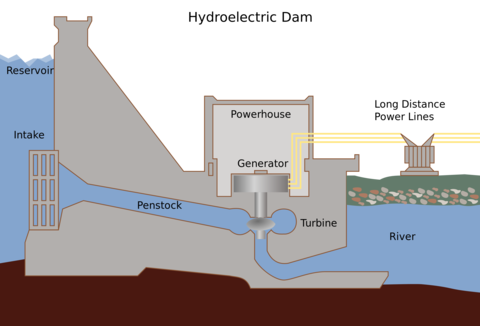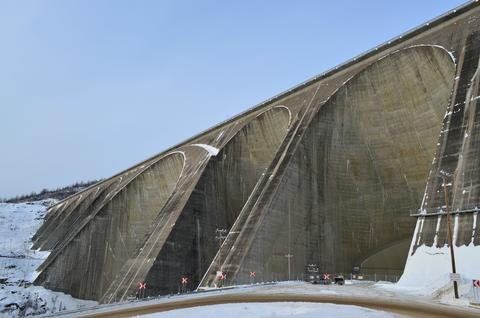Blogs in Motion: Hydroelectric Energy
Welcome back to Blogs in Motion! Our general-topic blog designed for discussion.
In this article, we’ll be taking a look at the form of alternative energy that first inspired this whole series: hydroelectric. Last year, in the cold north of Quebec, we first took in the sight of the awe-inspiring Robert Bourassa Dam and our time there drove us to investigate how alternative energy impacts the world. Hydroelectric is one of the more ancient forms of harnessing power, first conceived of by some of the earliest civilizations, such as the ancient Greeks using water wheels for grinding wheat into flour over 2,000 years ago. Since that time, electrical energy generated by flowing water has been harvested in larger quantities and in much larger facilities. Before we get into the potential of hydroelectric power as a long-term energy source, we’ll start with the basics of how it works.

How is hydroelectric energy generated? The process involves the harnessing of the inherent kinetic energy in flowing and falling water. A dam is built in place to raise the water levels of a body of water and to control the now-redirected flow. Hydroelectric dams vary greatly in their size, from “micro-dams” that can provide enough power for a small, local community to giant dams, such as the Hoover Dam, that can provide partial power for entire cities. The redirected water enters the dam’s reservoirs and falls against a series of turbines. The turbines operate in a manner very similar to wind turbines; the falling water hits the turbines and causes them to spin, the kinetic motion generating harvestable energy. The hydroelectric energy is then distributed through transmissions lines from the dam to local homes, businesses etc.
Now that we have a basic understanding of how hydroelectric power is harvested, let’s ask ourselves: What are the potential benefits of supporting global energy demand with hydroelectric power?
One of the biggest benefits of hydroelectric energy is its renewable potential. This energy relies on the motion of water, one of the most abundant resources on Earth, and because it is generated through falling water and spinning turbines, there are little to no fluctuations in the process of providing electricity. The energy produced by hydroelectric plants/dams also does not produce any of the contaminants or greenhouse gases typically associated with fossil fuels, making it a viable “green” option for alternative power. Additionally, hydroelectric plants/dams have lower operating costs and maintenance requirements. Some of the largest hydro dams can require a staff of as little as 50 people to operate and once a dam is in place, there are so few parts that usually require fixing or replacing, it’s seen as very cost effective once the dam is established.
The impact on local communities near hydroelectric plants can also have some positive side-effects. Due to the non-intermittent nature of hydroelectric power, it offers a more permanent option for stable energy for nearby communities, as opposed to solar or wind which can fluctuate depending on local factors. Also, by creating calmer bodies of water for the dams, opportunities for recreational activities such as fishing, boating or swimming become available to locals. Often there is excess power available for export at a profit.

The Daniel-Johnson Dam in northern Quebec, Canada
No method of generating energy is perfect, so let’s ask ourselves now: What are the drawbacks of increasing our dependence on hydroelectric power?
The most common issue brought up with hydroelectric dams is the potential environmental impact of the damming process and how changing water flows and installation of new power lines and roads impacts the local wildlife and terrain. Construction of hydroelectric dams is no small order, taking up a large area of space and altering water flows. This could potentially disrupt the nearby wildlife, fish in particular. Fish habitats and migration patterns can be greatly impacted by the changing of water levels and/or velocity of running currents. Specialists are still researching the specifics, but there is a strong debate already for the environmental impact of a dam’s existence.
Droughts can also be a major factor to hydro dams, with lower water levels potentially causing a shortage of electrical production, which could be a particular annoyance if the dam services a local community. Also, while the day-to-day operating costs of hydro dams is reportedly low, the initial costs to build the dam can be quite high and zoning/construction issues can quickly become a factor. However the low costs of maintenance and staffing afterwards are often see as an appropriate balance, so it’s worth taking both sides into account.
What are your thoughts on the use of hydroelectric energy? Should we increase or decrease our dependence on the power of hydroelectric dams? How far do the environmental considerations go against the considerations of stable, long-term energy? Let us know in the comments below or on our social media channels. We hope you've found these articles informative and we’ll have our final entry on geothermal power up soon!
Images are original Trailer Blocks content.
Hi! I am a robot. I just upvoted you! I found similar content that readers might be interested in:
https://www.trailerblocks.com/blogs/trailer-blocks-blog/47170501-blogs-in-motion-a-future-matter-hydroelectric-power